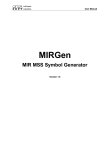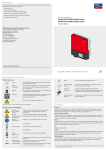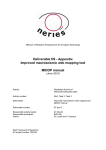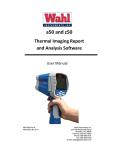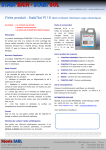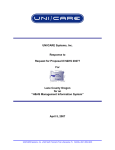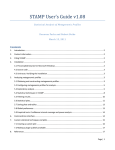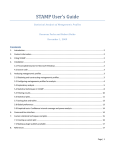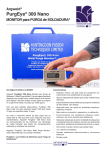Download dbLabCal V3 Administration
Transcript
dbLabCal V3 Administration dbLabCal V3SP8 Administration Table of Contents 1 HARDWARE AND SOFTWARE REQUIREMENTS ..................................................................................................... 3 2 INSTALLATION ........................................................................................................................................................ 4 2.1 ORACLE DATABASE INSTALLATION ON THE DATABASE SERVER ....................................................................................... 4 2.2 ORACLE DATABASE CONFIGURATION FOR DBLABCAL (INSTANCE AND/OR SCHEMA CREATION) ............................................ 4 2.2.1 Instance .................................................................................................................................................. 4 2.2.2 Schema (DBA user dblabcal) ............................................................................................................. 5 2.3 DBLABCAL SCHEMA CONFIGURATION ................................................................................................................... 5 2.4 COPY DBLABCAL.EXE INTO SERVER SHARE ................................................................................................................. 6 2.5 ORACLE CLIENT INSTALLATION (EACH CLIENT PC)....................................................................................................... 7 2.6 DBLABCAL CLIENT INSTALLATION (EACH CLIENT PC) .................................................................................................. 7 2.7 LIC FILE ............................................................................................................................................................. 7 2.8 INITIAL CONFIGURATION OF DBLABCAL DATABASE ..................................................................................................... 8 3 MAINTENANCE ....................................................................................................................................................... 8 4 ADMINISTRATION .................................................................................................................................................. 9 4.1 4.2 4.3 5 USER ACCOUNT ADMINISTRATION .......................................................................................................................... 9 USER GROUPS ADMINISTRATION .......................................................................................................................... 10 DEPARTMENT ADMINISTRATION ........................................................................................................................... 11 APPENDIX ............................................................................................................................................................. 12 5.1 5.2 5.3 5.4 5.5 5.6 SQD FILE STRUCTURE (FOR DATA IMPORT) ............................................................................................................. 12 ASCII FILE STRUCTURE (FOR DATA EXPORT) ............................................................................................................ 13 DBLABCAL.ADM FILE ........................................................................................................................................... 14 DBLABCAL.INI FILE.............................................................................................................................................. 14 DBLABCAL.EXT FILE ............................................................................................................................................ 15 DBLABCAL.IMP FILE ............................................................................................................................................ 17 2 dbLabCal V3SP8 Administration 1 Hardware and Software Requirements dbLabCal V3 works with all current Oracle database versions. Recommended DBMS is Oracle12cR1, Oracle11gR2 or OracleXE (11g) and an Oracle11 client. The Oracle database may run on any server type (Windows, Unix, Linux etc.). Oracle database versions from 8.1.7 up to Oracle 12c were tested. Hardware requirements for the database server: Minimum Processor Intel (x86) Memory 2 GB OS W7 Pro or higher, 64bit or Windows Server 2008 R2 Disk space 1.5 GB minimum Windows Installer MSI version 2.0 minimum Network TCP/IP Resolution 1024x768 Recommended N/A 4 GB or more Windows Server 2008 R2 or Windows Server 2012 R2 10 GB for Oracle and Data N/A N/A N/A For details see also: Oracle 12c Release 1: http://docs.oracle.com/database/121/index.htm Oracle 11g Release 2 (11.2): http://docs.oracle.com/cd/E11882_01/server.112/e10897/install.htm#ADMQS002 Oracle Database Express Edition 11g Release 2 (XE 11.2): http://docs.oracle.com/cd/E17781_01/index.htm dbLabCal V3 client runs on any computer which is suitable for Windows operating system. All current Windows versions up to Windows 8.1 were tested. In addition, Oracle client software which is compatible with the used Oracle database (DBMS) version must be installed on each client PC. Recommended version is client version Oracle11g, the 32-bit version is mandatory. Hardware requirements for the dbLabCal client: Minimum Processor Intel (x86) Memory 2 GB OS Any Windows 7 Disk space 1.5 GB minimum Resolution 1024x768 Recommended N/A 4 GB W7 Pro or W8.1 Pro or higher, 64bit 1.5 GB minimum 1980x1200 3 dbLabCal V3SP8 Administration 2 Installation Full dbLabCal installation consists of following steps: 2.1. 2.2. 2.3. 2.4. 2.5. 2.6. 2.7. 2.8. Oracle database installation on the database server Oracle database configuration for dbLabCal (instance and/or schema creation) dbLabCal schema configuration copy dblabcal.exe plus config and license files into a shared folder Oracle client (including OO4O) installation on each dbLabCal client PC dbLabCal client package installation on each dbLabCal client PC License file configuration Initial configuration of dbLabCal database (definition of departments, chromatographic systems and user in the database) Perform steps 2.1-2.7 as administrator, step 2.8 as dbLabCal administrator 2.1 Oracle Database installation on the database server Install Oracle DBMS version on the database server according Oracle’s instructions. No special requirements for dbLabCal exist. Download links for Oracle Database 12c Release 1, Oracle Database 11g Release 2 or Oracle Database 11g Express Edition: http://www.oracle.com/technetwork/database/enterprise-edition/downloads/index.html 2.2 Oracle Database configuration for dbLabCal (instance and/or schema creation) 2.2.1 Instance Create new instance for dbLabCal with Oracle’s Database Configuration Assistant (DCA). It is also possible to use any already existing instance. You may also create tablespaces for dbLabCal data or just use Oracle’s defaults. The only requirement of dbLabCal is to having an own schema. Check in DCA that following options are ON for the instance to be used by dbLabCal: - Configure DB with EM - Enable Daily Backup - Flash Recovery Area - Archiving - EM Repository - Character set is UTF8 4 dbLabCal V3SP8 Administration 2.2.2 Schema (DBA user dblabcal) Create the DBA user dblabcal e.g. by executing following 3 sql statements in sqlplus or sqldeveloper: create user dblabcal identified by DBLABCAL; grant DBA to dblabcal; alter profile DEFAULT limit PASSWORD_LIFE_TIME UNLIMITED; 2.3 DBLABCAL Schema Configuration All database objects required for dbLabCal are created with the tool dbcreora.exe. dbcreora.exe may be also helpful to re-create potentially corrupted objects like sequences, triggers, constraints or indexes. Start dbcreora.exe from ...\dblabcal.v3\setup\create_dblabcal_schema\ folder and login as the DBA user DBLABCAL created in section 2.2.2. All required objects are created after click on the START! button. dbcreora.exe creates also another one DBA user (with USERID of the current Windows user) and grants dbLabCal administrator permissions to this user. Check also the output in dbcreora.exe (dbcreora.log file) for details! 5 dbLabCal V3SP8 Administration 2.4 Copy dblabcal.exe into server share Copy the content of the dbLabCal installation media into a share dblabcal created on the database server. bin folder docs folder 6 dbLabCal V3SP8 Administration 2.5 Oracle Client installation (each client PC) Start setup.exe (on each client PC) from ...\dblabcal\_setup\setup_oracle_client\ to install the 32-bit Oracle client. Only the Oracle11g 32-bit client has Oracle Object for OLE (OO4O) required by the dbLabCal! Select the Administrator option for the Oracle client installation. Following item must be selected if for some reason User defined installation option is required: - Oracle Object for OLE - Oracle database utilities 2.6 dbLabCal Client installation (each client PC) Start setup.exe (on each client PC) from ...\dblabcal\_setup\setup_dblabcal_client\ and create shortcut to ...\dblabcal\bin\dblabcal.exe on the desktop 2.7 LIC File Copy dbLabCal’s license file dblabcal.lic together with the dblabcal.ini file *)into a shared folder on a server. Oracle client (32-bit Oracle client!) must be installed on the database server in addition to the database components. The path to the share of dblabcal.lic file is set in the dblabcal.adm (administration) file: [Database] … lic=\\dbservername\dblabcal\ *) … Corresponding ini file has entries directing back to dblabcal.exe path and to the database instance: [dblabcal] path=\\appservername\exefoldername\dbLabCal\ db=dbservername/dblabcal *) dblabcal.ini file is not required if dblabcal.exe, dblabcal.adm and dblabcal.lic are in same folder 7 dbLabCal V3SP8 Administration 2.8 - Initial Configuration of dbLabCal database Login as administrator or an user with write permissions to ...\dblabcal.v3\bin\ folder Edit dblabcal.adm file in ...\dblabcal.v3\bin\ folder: Use easy connect naming DBSERVERNAME/INSTANCENAME to connect to the database or edit tnsnames.ora. tnsnames.ora is either local or on shared location (set global environment variable TNS_ADMIN to shared path). Example tnsnames.ora: dblabcal = (DESCRIPTION = (ADDRESS_LIST = (ADDRESS = (PROTOCOL = TCP)(HOST = dbservername)(PORT = 1521)) ) (CONNECT_DATA = (SERVICE_NAME = DBLABCAL) ) ) - - 3 Start dbLabCal V3 Enter ORACLE ADMIN PASSWORD (password of the user DBA dblabcal) Enter ORACLE USER PASSWORD (Password of the user who has created dblabcal schema with dbcreora.exe. Password is by default dblabcal. Check also the dbcreora.log file) Edit Departments Edit Users Maintenance Only standard Oracle database maintenance procedures are required. Also, there is no need to work in Oracle database directly after database was once created and the database backup was established and checked. 8 dbLabCal V3SP8 Administration 4 Administration For additional information, see also the db menu chapter in dbLabCal User Manual. 4.1 User Account Administration New Account DB menu -> USERS... , NEW, edit user, finish with click on button SAVE... If the new user is not „ReadOnly“ user (means the user is involved in measurements) click the check box . 9 dbLabCal V3SP8 Administration Change Account, Reset Password DB menu -> USERS... , make changes in dialog, finish with click on button SAVE... Lock / Unlock Account User is locked by Oracle automatically after specific period of inactivity (locked timeout) To unlock a user, proceed as described in Change Account (e.g. change password). The account will be automatically unlocked when changing the users password. 4.2 User Groups Administration dbLabCal users can be grouped in departments (groups). There are 6 fixed user types: - ReadOnly - Analyst - Study Director/BPI - Department Manager - QA - Administrator Permissions for each User types cannot be further edited. For additional information, see User Authorization chapter in dbLabCal User Manual. 10 dbLabCal V3SP8 Administration 4.3 Department Administration db menu -> Departments... , make changes in dialog, finish with click on button Save... Check box means the department and the (selected) instruments will be showed-up in various dialogs for selection when editing projects in dbLabCal. Furthermore, all users of the department can be set to not „active“ by deselecting the check box „has instruments“. 11 dbLabCal V3SP8 Administration 5 Appendix 5.1 SQD File Structure (for data import) Line 1 2 3 4 5 6 7 8 9 10 11 Type text numeric text numeric text text text text text text numeric * * * * * * Content DBLABCAL SQD ASCII FILE sequence (run) number Comment unit number analyst name sample preparation date sequence (run) start date sequence (run) end date study code Matrix peak count Comment File Header (first line is fixed text to identify the file as dblabcals file) Header Start for P=1 to peak count text numeric * name of peak P ID of peak P numeric * Chromatogram count # # # # # text text text numeric text * * + + + # # # # # text Text numeric Text numeric + + * Chromatogram file name sample type (TXTSYSIN, IDs 1-7) subject number or subject name or sample name for DIV period number Time expressed as: -number (e.g. 14=14 hours) or -dhm-Text (e.g. 3d2h30m=3 days, 2 hours, 30 minutes) or -hhh:mm-Text (e.g. 018:30=18 hours, 30 minutes) Temperature (TXTSYSIN, IDs 11-15,) Matrix (TXTSYSIN, IDs 21-24) Dilution factor Remark to chromatogram Flag if chromatogram to be imported into database text numeric numeric numeric numeric numeric numeric numeric * + * * * * * * 12 .... next P # File Header End for C=1 to chromatogram count (CAL, QCS, SUB, VAL, DIV, EQC) (SUB, DIV) (SUB and/or VAL) (VAL) (VAL) for P=1 to peak count # # # # # # # # Chromatogram flag for peak P in chromatogram C (TXTSYSIN, IDs 31-39) Nominal conc. for peak P in chromatogram C Retention time for peak P in chromatogram C area for peak P in chromatogram C Height for peak P in chromatogram C Retention time for IS for peak P in chromatogram C area for IS for peak P in chromatogram C Height for IS for peak P in chromatogram C (J/Y, N, S, V, A/E, X) (CAL, QCS, VAL) if no peak; = 0 if no peak; = 0 if no peak; = 0 if no peak or IS not used; = 0 if no peak or IS not used; = 0 if no peak or IS not used; = 0 next P next C * a value must be in this line + may be left as blank line (if required, the data may be edited later in the database) 12 dbLabCal V3SP8 Administration 5.2 ASCII File Structure (for data export) This is the format of the plain ASCII file which contains the results of the subject samples. This ASCII file may be used to import the results into another applications, e.g. for biometrical calculations (SAS). Column 0 1 2 3 4 5 6 1234567890 1234567890 1234567890 1234567890 1234567890 1234567890 line 1 2 3 4 5 6 7 8 9 10 11 12 13 14 15 16 17 18 19 etc. PROJECT... SPONSOR... GLPCODE... ANALYTE... MATRIX.... COMMENT... .......... .......... .......... .......... .......... .......... .......... .......... .......... .......... .......... .......... .......... XXXXXXXXXX YYYYYYYYYY ZZZZZZZZZZ Analyte... Matrix.... Comment.to (blankline .......... .......... .......... .......... .......... .......... .......... .......... .......... .......... .......... .......... XXXXXXXXX. .......... .......... Name...... Name...... Project... )......... ...SUBJECT .........1 .........1 .........1 .........1 .........1 .........1 .........1 .........1 .........1 .........1 .........1 .......... .......... .......... .......... .......... .......... .......... ....PERIOD .........1 .........1 .........1 .........1 .........1 .........1 .........1 .........1 .........1 .........1 .........1 .......... .......... .......... .......... .......... .......... .......... ...TIME[h] .....0.000 .....0.033 .....0.083 .....0.167 .....0.250 .....0.500 .....0.750 .....1.000 .....2.000 .....6.000 ...120.000 .......... .......... .......... .......... .......... .......... .......... .....ng/ml .....<2.50 ......19.2 ......20.0 ......20.7 ......24.0 ......48.6 ......51.6 ......NOS ......54.0 ......55.9 ......56.7 NOS: no sample NOA: sample not analyzed (received sample was not needed to be analyzed according to protocol, chromatogram flag was set to I) NOR: result not reported (sample available and analyzed but no valid conc. result obtained) 13 dbLabCal V3SP8 Administration 5.3 dblabcal.adm File dblabcal.adm is a control file for dblabcal.exe. It is used by dbLabCal V3 to login into the database and must be in the same folder as dblabcal.exe The section entries are: [Database] oradsn= database connection (either tnsnames.ora or easyconnect) [Admin] name= Oracle schema(=Oracle user) used to store the data (default=DBLABCAL) PWD= password for the Oracle schema(=Oracle user) [Mill] loginproject= name of valid/existing Empower project to login (to check users Millennium password) Examples.... [Database] ;Production (example easy connect) oradsn=svrname/dblabcal ;DEV (example tnsnames.ora) ;oradsn=dblabcalDEV [Admin] name=DBLABCAL PWD=8D0683C06C6A06………… [Mill] loginproject=TEST ;loginproject must be a valid Empower project ;otherwise login errors in Import dialog 5.4 dblabcal.ini File dblabcal.ini is a control file for dblabcal.lic. It is used to set dblabcal.exe location and the database connection. It is required for the license file. The section entries are: [dblabcal] path=\\FILESERVERNAME\path_to_dblabcalexe\ db=DBSERVERNAME/INSTANCENAME Examples.... [dblabcal] path=\\FILESERVERNAME\dblabcal\bin\ db=DBSERVERNAME/XE 14 dbLabCal V3SP8 Administration 5.5 dblabcal.ext File dblabcal.ext is a control file for dblabcal.exe. dblabcal.ext is used by dbLabCal V3 to fill its Extra menu. Extra menu allows the user to start any application / document from dbLabCal directly. It saves few clicks It can be missing, but if used, it must be in the same folder as dblabcal.exe It has one fixed section [dbLabCalExt]. Max. 25 entries are used for the Extra menu. The section entries are: Program / Document description to be displayed in the Extra menu = full path to program or document with parameter list if applicable for that particular program/document the parameters will be replaced by dbLabCal with current database values before the called program will be started #databasemodus# #databasename# #studyid# #studycode# #sponsorcode# #studycomment# #peakid# #peakname# #matrix# #analyticalmethod# #concunit# #regmodel# #regweighting# #regreadings# #seqid# #seqnumber# #sequnit# #seqcomment# #seqextracted# #seqstarted# #seqended# #seqcalculated# #reg_a# #reg_b# #reg_c# #reg_r2# #selection# #set_peaknames# #set_cals# #set_qcs# #set_vals# #set_subjects# #set_periods# #set_times# 15 dbLabCal V3SP8 Administration Examples.... [dbLabCalExt] Notepad=c:\windows\notepad.exe Bug Report (e-mail)=mailto:[email protected]?Subject=dbLabCal V3 Bug report! Study:#studycode# Peak:#peakname#/#matrix#&Body=StudyID=#studyid#PeakID=#peakid#SeqID=#seqid# New in dbLabCal V3 (PDF-Dokument)=f:\pkg\dblabcal.v3\docs\winidblcV3.pdf dbLabCal V3 - Manual (PDF-Dokument)=f:\pkg\dblabcal.v3\docs\dblabcalv3de.pdf Recovery (Excel sheet)=f:\pkg\ExcelSheets\reco.d02.XLT Recovery with matrix effect for LC/MS (Excel sheet)=f:\pkg\ExcelSheets\reco_me.d02.xlt Stability Solutions (Excel sheet)=f:\pkg\ExcelSheets\StabiSol.d03.xlt Pipettes Calibration (Excel sheet)=f:\pkg\ExcelSheets\PipettenKalib.d01.xlt Sampler Calibration (Excel sheet)=f:\pkg\ExcelSheets\SamplerKalib.d02.xlt 16 dbLabCal V3SP8 Administration 5.6 dblabcal.imp File dblabcal.imp is a control file for dblabcal.exe. It must be in the same folder as dblabcal.exe dblabcal.imp is used to describe structure of ASCII file which should be used for data import into the dbLabCal database In the [Formats] section is a name list of all in the dblabcal.imp defined ASCII formats. There is no limit for the number of entries in the [Formats] section. The sequence of the entries is arbitrary The sections must be written exactly as in [Formats] section defined! e.g.: [Formats] 3=MacQuan(SIEX API300/365) . . [MacQuan(SIEX API300/365)] column.....=...etc 17 dbLabCal V3SP8 Administration the section entries are: file_analyte_name=3,1,20 file_analyte_name=-1,1,20 file_analyte_name=0,... data_after_line_starting_with=# data_before_line_starting_with=# data_after_line_starting_with=0 data_before_line_starting_with=0 column_separator=ASCII code column_filename= column_samplename= column_rt= column_area= column_ht= column_rtIS= column_areaIS= column_htIS= column_df= column_date= column_analyte_name= row number, first character, last character (means the analyte name is written in the ASCII file in the 3rd row, between columns 1 – 20 negative row number means row number is counted from the end of the ASCII file means last row (or first row from the end...) means, there is no information on the analyte name in the ASCII file (data of each chromatogram starts after row #,the first position of chromatogram data is row #+1) (data of each chromatogram ends before row # the last position of chromatogram data is row #-1) means, the first position of chromatogram data is the first row of ASCII file means, the last position of chromatogram data is the last row of ASCII file ASCII code of the column separator character (ASCII code can be a number, e.g. column_separator=9, for TAB or a character , e.g. column_separator=| or column_separator=, etc) column number, of column containing the chromatogram file name/chromatogram id column number, of column containing the sample name column number, of column containing the retention time of the analyte column number, of column containing the peak area of the analyte column number, of column containing the peak height of the analyte column number, of column containing the retention time of the internal standard column number, of column containing the peak area of the internal standard column number, of column containing the peak height of the internal standard column number, of column containing the sample dilution factor column number, of column containing the date/time of the chromatogram analysis column number, of column containing the analyte name (with the above measured values) (either file_analyte_name= or column_analyte_name= is possible if file_analyte_name<>0 then column_analyte_name is ignored file_analyte_name<>0 means: 1 file = 1 analyte column_analyte_name<>0 means: 1 file = all analytes of one chrm.run … 18 dbLabCal V3SP8 Administration Example.... ;dblabcal.imp is a control file for dblabcal.exe ;it must be in the same folder as dblabcal.exe ;it is used to describe structure of ASCII file ;which should be used for data import into dbLabCal database ;-----------------------------------------------------------------;dblabcal.imp can be used for any (defined) ASCII file format ;-----------------------------------------------------------------; ; ;in the [Formats] section is a name list of all in the dblabcal.imp ;defined ASCII formats ;there is no limit for the number of entries in the [Formats] section ; ;the following section must be written exactly as in [Formats] section defined! ; ; ;the entries are: ; ;----------------------------------------------------------------------------------------------------------------------------;;data_FirstLine= OR data_after_line_starting_with= is used ;;special case: data are already in the 1st line, then there were no entry for data_after_line_starting_with possible ;data_FirstLine= ;data_after_line_starting_with=text (data of each chromatogram starts after row x) ; (the first position of chromatogram data is row x+1) ;data_before_line_starting_with=text (data of each chromatogram ends before row x) ; (the last position of chromatogram data is row x-1) ;data_after_line_starting_with=0 means, the first position of chromatogram data is the first row of ASCII file ;data_before_line_starting_with=0 means, the last position of chromatogram data is the last row of ASCII file ; ;data_ignore_if_name=text means don't import this line if sample name column content is "text", used for Magellan ; ; ;data_project=row, col ;data_unit_name=row, col ;data_batch_number=row, col ;data_batch_comment=row, col (used for FACS) ;data_batch_user=row, col (used for FACS) ;data_extraction_date=row, col ;data_start_date=row, col (used for FACS) ;data_end_date=row, col ; ; ;column_separator=ASCII code of the column separator character (for example column_separator=9, for TAB) ; or the character (for example column_separator=|, column_separator=, column_separator=;) 19 dbLabCal V3SP8 Administration ;----------------------------------------------------------------------------------------------------------------------------; ; ;1file_1peak= 1 if 1file = 1peak, 0 if 1file=all peaks from a chromatogram ;----------------------------------------------------------------------------------------------------------------------------;if 1file_1peak=1 ;file_analyte_name= row number, first character, last character ;file_analyte_name=3,1,20 means the analyte name is written in the ASCII file in the 3rd row, between the columns 1 and 20) ; ;negative row number means row number counted from the end of the ASCII file ;file_analyte_name=-1,1,20 means last row (or first row from the end...) ;file_analyte_name=0,... means, there is no information on the analyte name in the ASCII file ; ; ;column_filename= column number, of column containing the chromatogram file name/chromatogram id ;column_samplename= column number, of column containing the sample name ;column_rt= column number, of column containing the retention time of the analyte ;column_area= column number, of column containing the peak area of the analyte ;column_ht= column number, of column containing the peak height of the analyte ;column_rtIS= column number, of column containing the retention time of the internal standard ;column_areaIS= column number, of column containing the peak area of the internal standard ;column_htIS= column number, of column containing the peak height of the internal standard ;column_df= column number, of column containing the sample dilution factor ;column_date= column number, of column containing the date/time of the chromatogram analysis ;column_analyte_name= column number, of column containing the analyte name (with the above measured values) ;column_samplename_starts_after= last! character(s) after which the sample name starts (within the column "column_samplename") if empty, sample name starts at position 1 of the column "column_samplename" ;column_samplename_ends_before= first! character(s) before which the sample name ends (within the column "column_samplename") if empty, sample name ends with the end of the whole column "column_samplename" content ;column_sampletype= column number, of column containing CAL, QCS, VAL, SUB, DIV, KON ;column_sampleinfo= column number, of column containing DIVtext, SUB##, , SUB####### ;column_sampleperiod= column number, of column containing period for SUB ## ;column_sampletime= column number, of column containing time for SUB VAL ;column_samplematrix= column number, of column containing for VAL ;column_sampletemp= column number, of column containing for VAL ;column_nomconc= column number, of column containing CAL, QCS, VAL ;column_samplecomment= column number, of column containing comment ;----------------------------------------------------------------------------------------------------------------------------; ;columns for Magellan (double assays) ;*.asc 20 dbLabCal V3SP8 Administration ;column_samplename2= ;column_readings= ;column_values= ;column_calcconcMEAN= ;column_calcconcCV= ;column_calcconcDEV= ;MEAN, DEV, SD, CD are imported from Magellan ; ;columns for Access2 (double assays) ;*.csv ;column_samplename is Patienten-ID ;column_filename is Proben-ID ;column_calcconc is Ergebnis ;column_values is RLU ;column_calcconc ;column_date ;MEAN, DEV, CV are calculated in dbLabCal ;----------------------------------------------------------------------------------------------------------------------------; ;if 1file_1peak=1 peaks in own ASCII file ;AND column_analyte_name=x,y(,z)peak name position (McQuan) ; ; ;if 1file_1peak=0 all peaks from a chromatogram in ONE ASCII file ;AND column_analyte_name=0 in different columns (FACS) ; ;or ;if 1file_1peak=0 all peaks from a chromatogram in ONE ASCII file ;AND column_analyte_name=x in one column (Analyst, Millennium) ; ;----------------------------------------------------------------------------------------------------------------------------;----------------------------------------------------------------------------------------------------------------------------;;analyte name is in row as defined in "data_after_line_starting_with=" ;----------------------------------------------------------------------------------------------------------------------------;column_analyte_name01= column number, of column containing the name of peak 1 ;column_analyte_name02= column number, of column containing the name of peak 2 ;column_analyte_name03= column number, of column containing the name of peak 3 ;etc... ;column_analyte_name10= column number, of column containing the name of peak 10 ;----------------------------------------------------------------------------------------------------------------------------; OR ;----------------------------------------------------------------------------------------------------------------------------;;analyte name is in specific row, col ;----------------------------------------------------------------------------------------------------------------------------;column_analyte_name01= row, column number, containing the name of peak 1 ;column_analyte_name02= row, column number, containing the name of peak 2 ;column_analyte_name03= row, column number, containing the name of peak 3 21 dbLabCal V3SP8 Administration ;etc... ;column_analyte_name10= row, column number, containing the name of peak 10 ;----------------------------------------------------------------------------------------------------------------------------;----------------------------------------------------------------------------------------------------------------------------; ; ;column_rt01= column number, of column containing the retention time of peak 1 ;column_area01= column number, of column containing the peak area of peak 1 ;column_ht01= column number, of column containing the peak height of peak 1 ;column_rtIS01= column number, of column containing the retention time of the internal standard for 1 ;column_areaIS01= column number, of column containing the peak area of the internal standard for 1 ;column_htIS01= column number, of column containing the peak height of the internal standard for 1 ;column_nomconc01= column number, of nomical conc. for Peak01 ; ;column_rt02= column number, of column containing the retention time of peak 2 ;column_area02= column number, of column containing the peak area of peak 2 ;column_ht02= column number, of column containing the peak height of peak 2 ;column_rtIS02= column number, of column containing the retention time of the internal standard 2 ;column_areaIS02= column number, of column containing the peak area of the internal standard 2 ;column_htIS02= column number, of column containing the peak height of the internal standard 2 ;column_nomconc02= column number, of nomical conc. for Peak02 ; ;etc.. ; ;column_rt10= column number, of column containing the retention time of peak 10 ;column_area10= column number, of column containing the peak area of peak 10 ;column_ht10= column number, of column containing the peak height of peak 10 ;column_rtIS10= column number, of column containing the retention time of the internal standard 10 ;column_areaIS10= column number, of column containing the peak area of the internal standard 10 ;column_htIS10= column number, of column containing the peak height of the internal standard 10 ;column_nomconc10= column number, of nomical conc. for Peak10 ; ; ;----------------------------------------------------------------------------------------------------------------------------; ;dblabcal.imp-Format-Description-END ;----------------------------------------------- 22 dbLabCal V3SP8 Administration [Formats] 1=*.csv (FACS) nocalc [*.csv (FACS) nocalc] column_separator=, 1file_1peak=0 file_analyte_name=0 data_project= data_unit_name= data_batch_number= data_batch_comment= data_batch_user= data_extraction_date= data_start_date= data_end_date= data_analyte_name01=1,3 data_analyte_name02=1,5 data_analyte_name03=1,7 data_analyte_name04=1,9 data_analyte_name05=1,11 data_analyte_name06=1,13 data_analyte_name07=1,15 data_analyte_name08=1,17 data_analyte_name09=1,19 ;data_analyte_name10=1,21 data_after_line_starting_with=_TAB_Sample ID ;data_before_line_starting_with= column_analyte_name01=1,3 column_analyte_name02=1,5 column_analyte_name03=1,7 column_analyte_name04=1,9 column_analyte_name05=1,11 column_analyte_name06=1,13 column_analyte_name07=1,15 column_analyte_name08=1,17 column_analyte_name09=1,19 column_analyte_name10=1,21 ;if column NN doesn't exist the PeakCount is automatically corrected... 23 dbLabCal V3SP8 Administration column_filename=0 column_samplename=2 column_samplename_starts_after= column_samplename_ends_before= column_df=0 column_area01=4 column_ht01= column_area02=6 column_ht02= column_area03=8 column_ht03= column_area04=10 column_ht04= column_area05=12 column_ht05= column_area06=14 column_ht06= column_area07=16 column_ht07= column_area08=18 column_ht08= column_area09=20 column_ht09= column_area10=22 column_ht10= 24

























